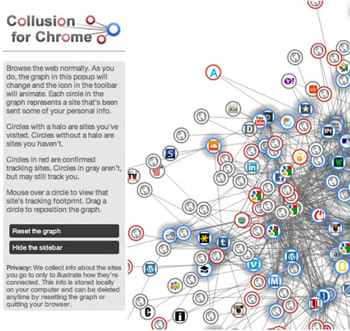Disconnect has released Collusion for Chrome, an open source extension which aims to graphically illustrate where your data is going while you cruise the web. Collusion was actually made available to Firefox about a month ago, but Disconnect has managed to port over their own, slightly tweaked version for Google's web browser.
Collusion breaks down your web surfing into an attractive, interactive, easy-to-understand bubble map. The extension makes it simple to discern websites you've visited and identify third parties who may have received information about your visit.
When a user visits a website, Collusion depicts it in real time as a blue node – circles with a blue outline. Connected to those site nodes, users will find all sorts of other third-party nodes representing trackers and other servers which are receiving data from their browser. Circles with red outlines indicate known tracking sites while gray circles represent possible, but unknown trackers. If a user clicks on any node, more information about that server is displayed.
As users visit more websites, more primary and third-party nodes will appear. Site nodes can be dragged around and pulled apart, but sites which share common tracker nodes will remain graphically linked together. As a result, Collusion provides a very effective (and fun) way to visualize previously visited websites and their respective third-party trackers.
Unfortunately, Collusion can do little to change or limit these third party connections. However, the visualization provided by Collusion may prove to be unsettling for privacy advocates.
Disconnect is the developer behind other privacy-centric extensions including Facebook Disconnect, Google Disconnect and Twitter Disconnect. The software development start-up was founded by former Google engineer Brian Kennish, the original developer of Facebook Disconnect.
- Get Collusion for Chrome by Disconnect
- Get Collusion for Firefox by Mozilla
